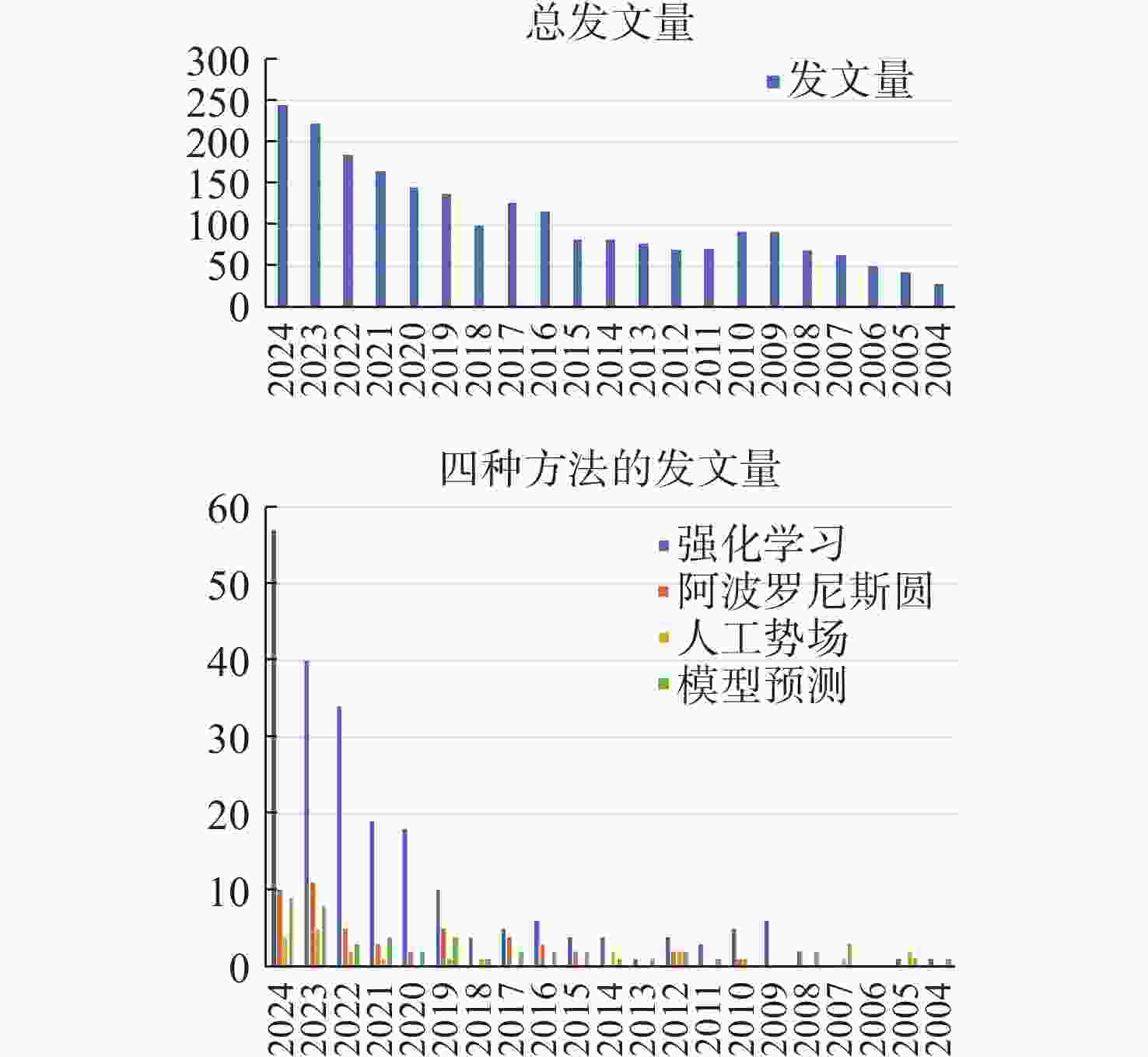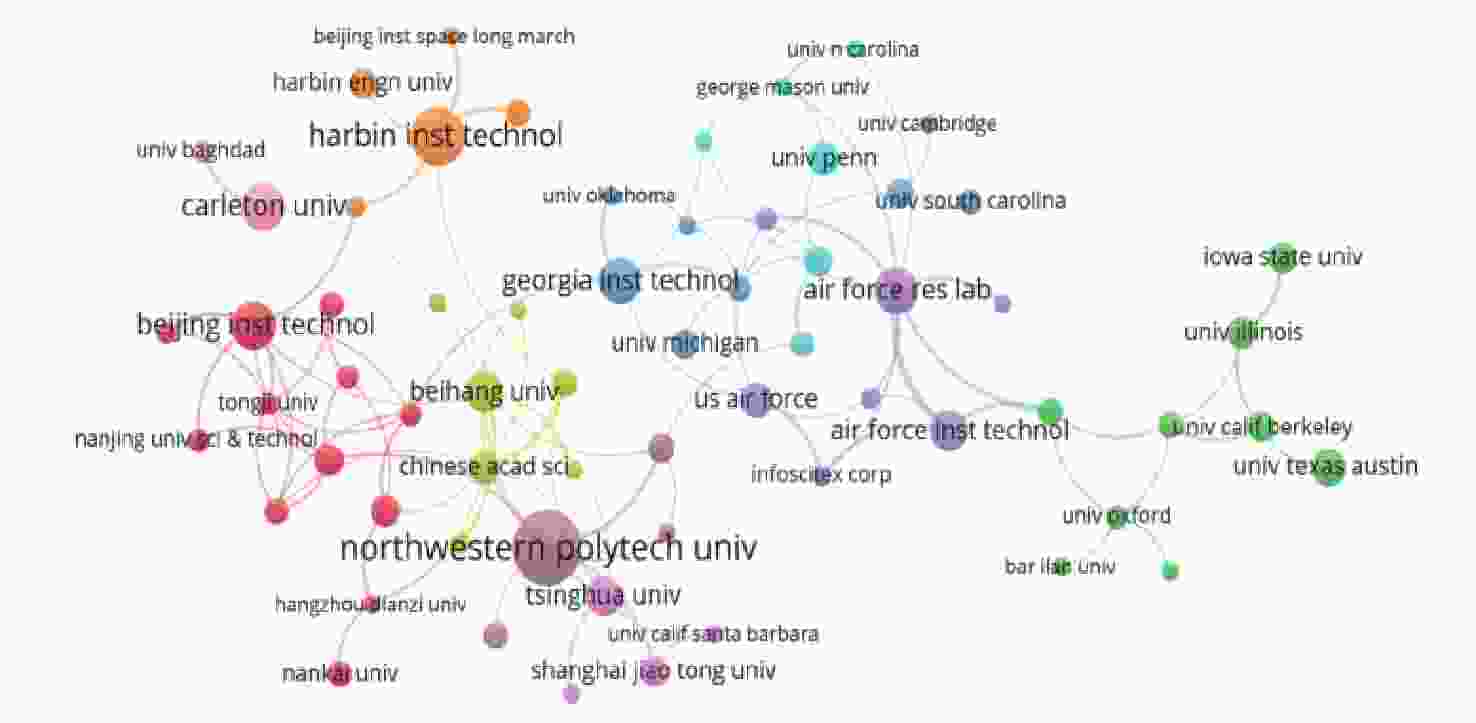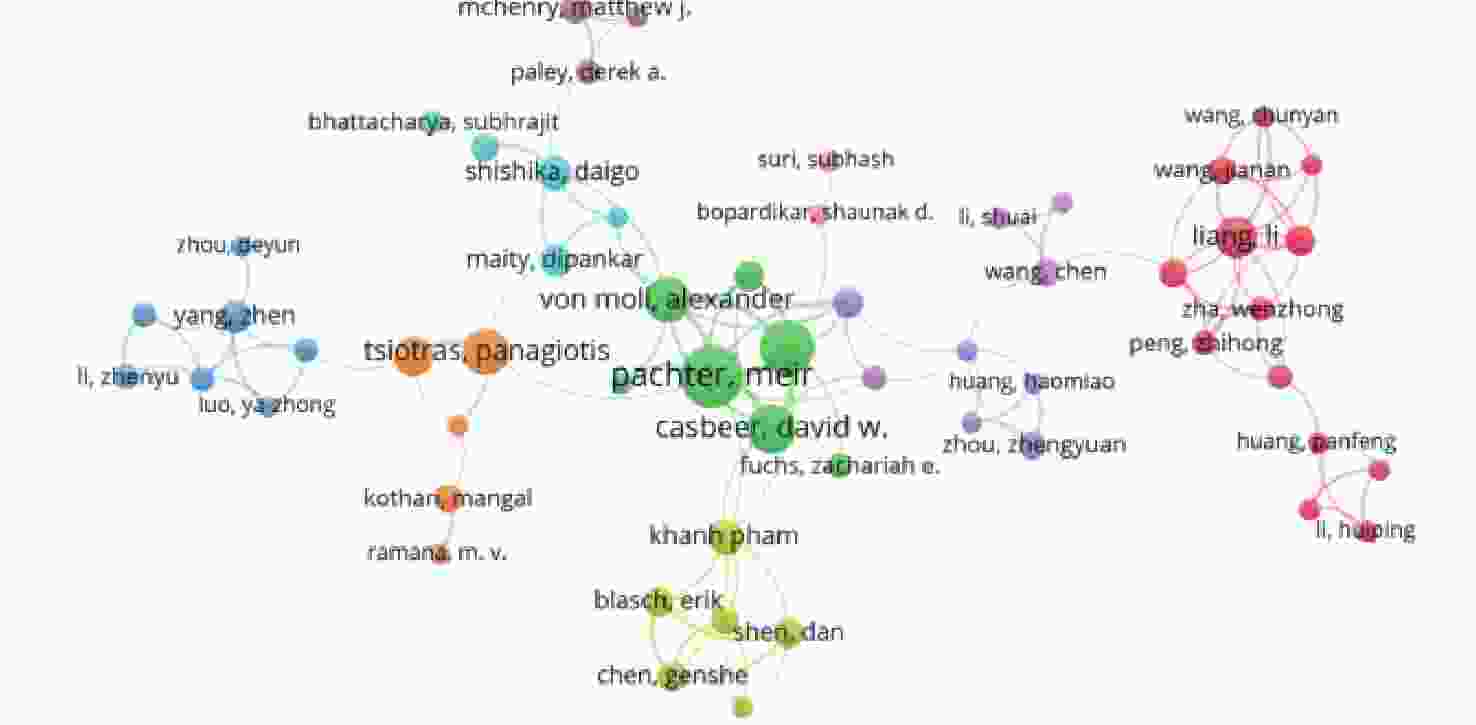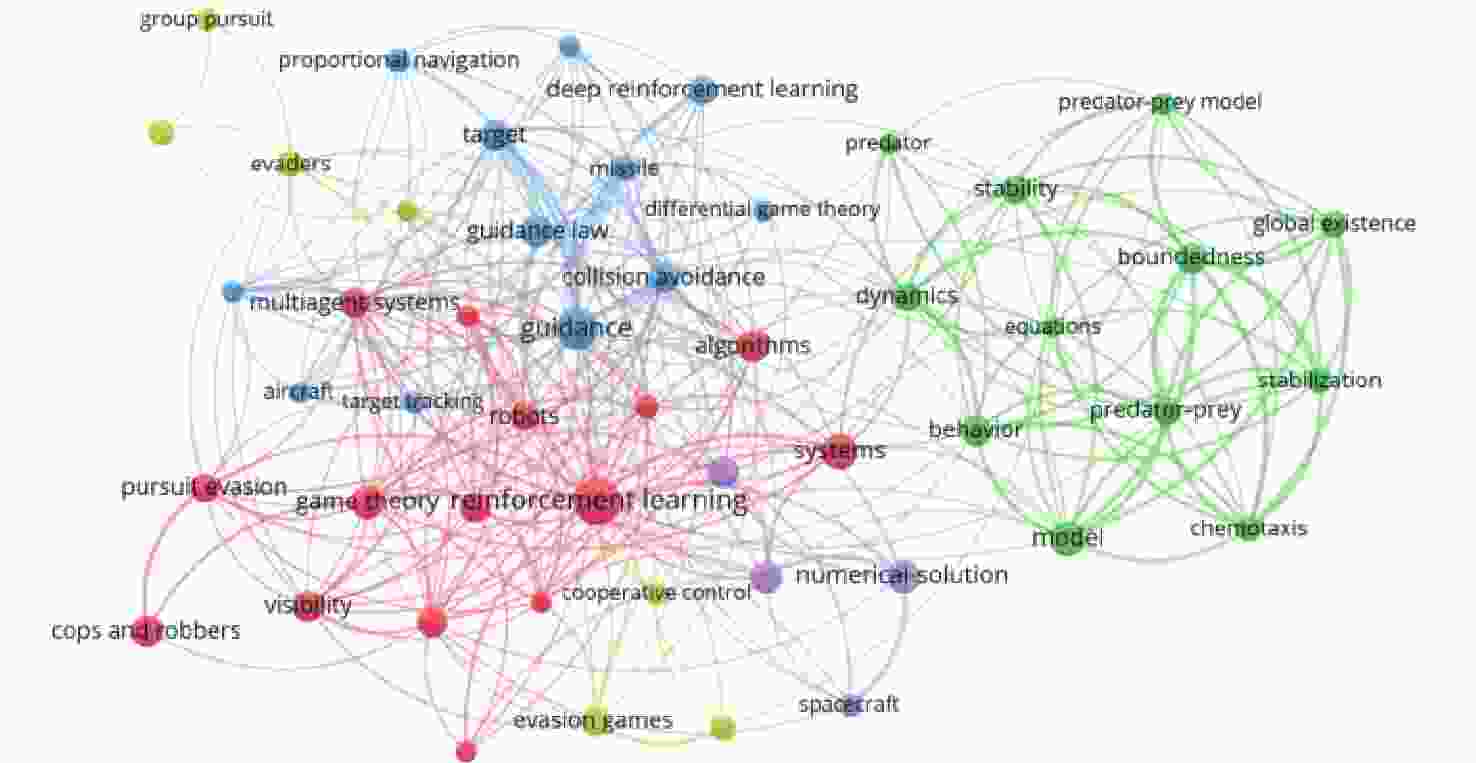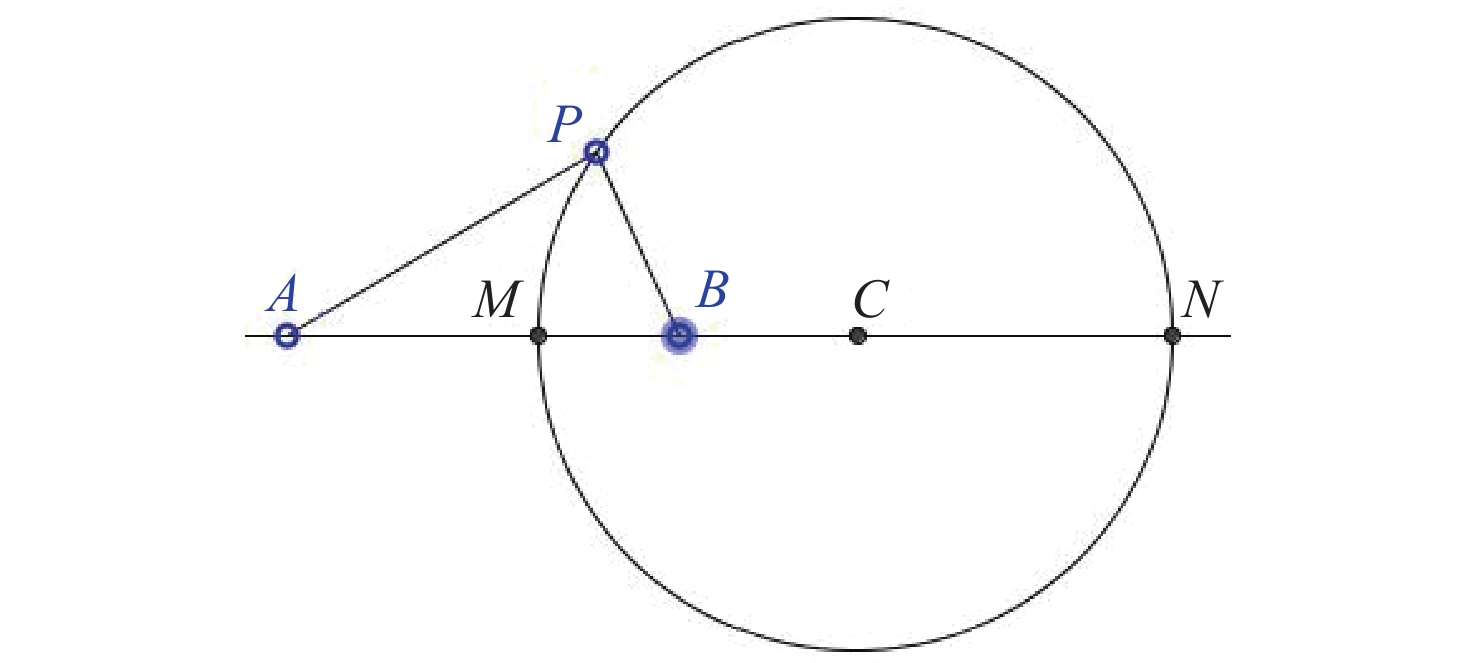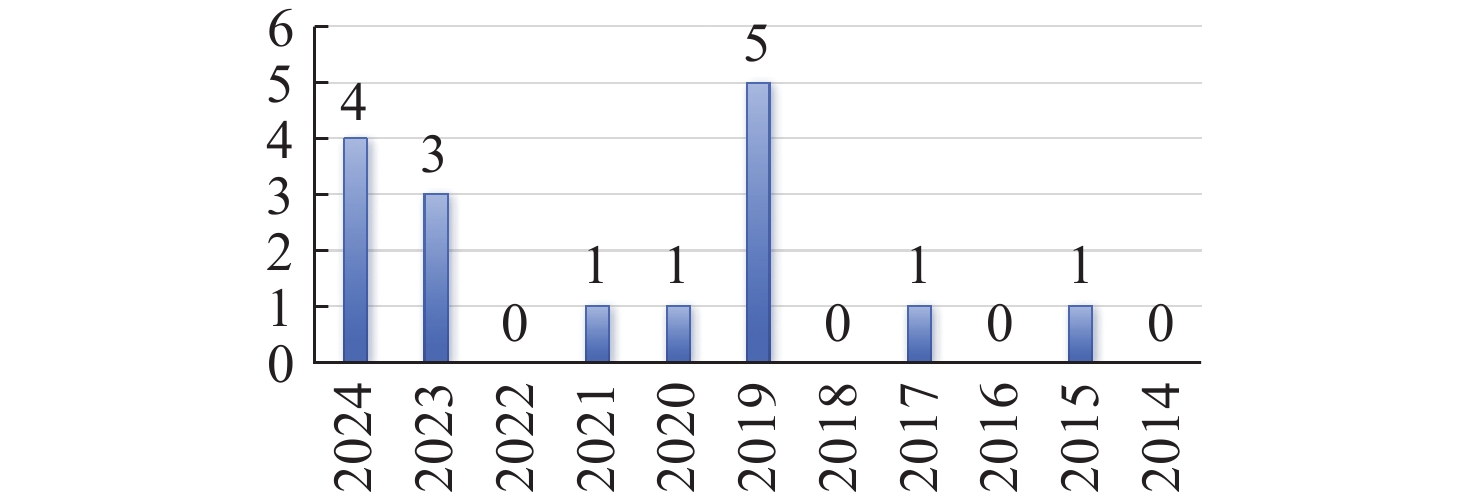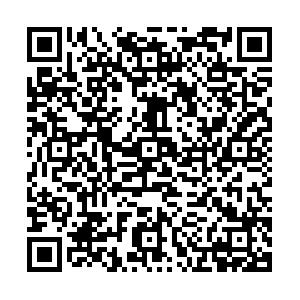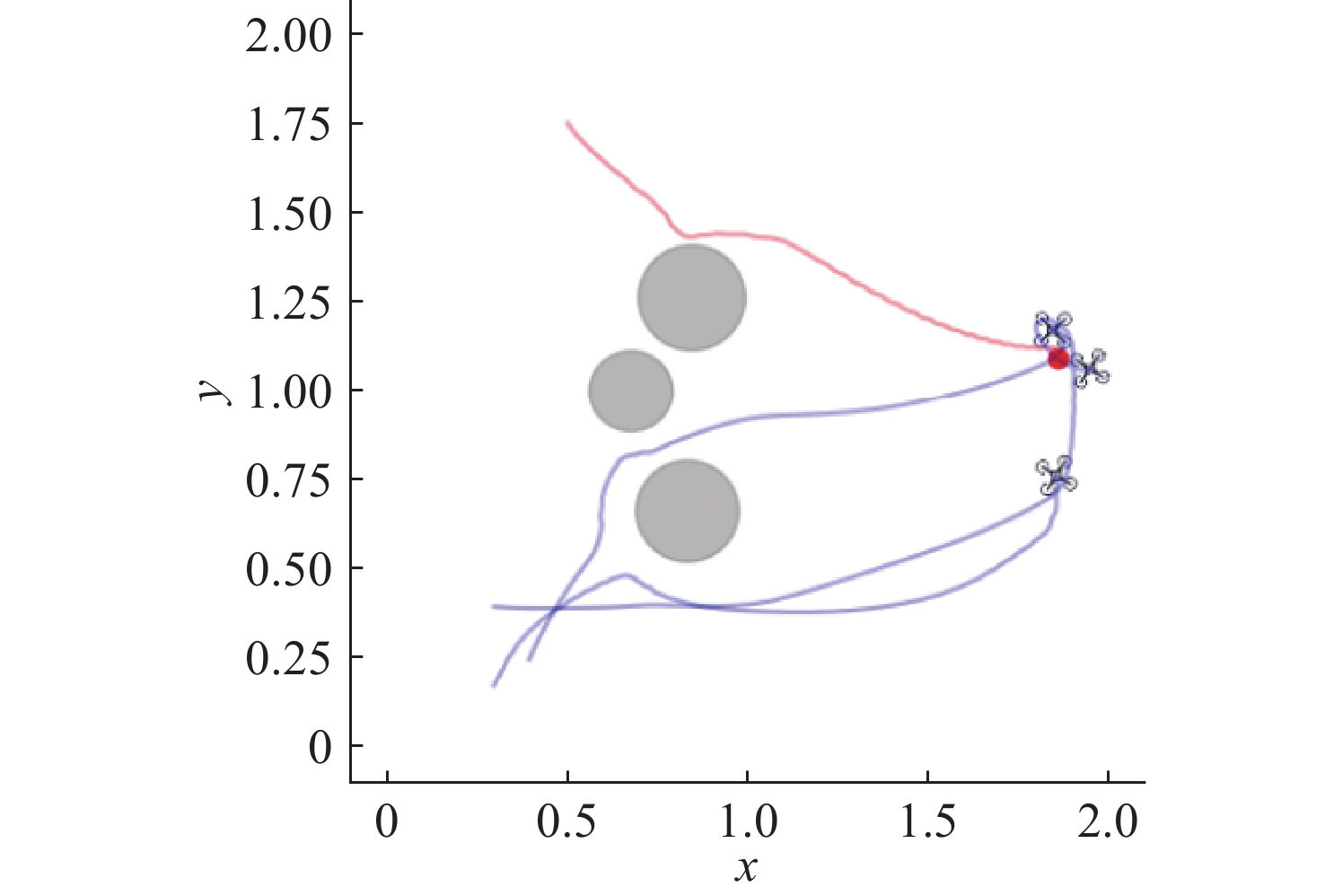Advances in multi-robot pursuit and its study in underwater environments
-
摘要: 本文旨在综述多机器人追逃问题的研究进展及其在水下环境中的应用和挑战。通过检索Web of Science Core Collection数据库, 筛选了2004-2024年间的
2200 余篇相关论文, 对追逃问题的定义、研究现状、智能追逃方法及其在水下环境中的应用进行了全面分析。重点分析了强化学习、模型预测控制、人工势场和阿波罗尼斯圆四种智能追逃方法, 探讨了它们的优缺点及适用性。研究发现, 强化学习通过训练优化策略以适应复杂环境, 然而训练周期较长; 模型预测控制基于未来状态预测来制定策略, 具有高准确度, 但实时性可能面临挑战; 人工势场法使用虚拟力场引导机器人, 而阿波罗尼斯圆则利用几何关系来优化路径。在水下环境中, 机器人追逃面临洋流扰动、通信受限等多重挑战。本文总结了现有方法在水下环境中的应用潜力和存在的问题, 并提出了未来研究方向, 包括开发更高效、适应性更强的智能追逃算法, 以应对复杂水下环境中的挑战。Abstract: This paper aims to review the research progress on multi-robot pursuit-evasion problems and their applications and challenges in underwater environments. By searching the Web of Science Core Collection database, over 2,200 relevant papers from 2004 to 2024 were selected. The paper comprehensively analyzes the definition, research status, and intelligent pursuit-evasion methods, with a focus on four key approaches: reinforcement learning, model predictive control, artificial potential fields, and Apollonius circles. It also explores their advantages, disadvantages, and applicability. The findings indicate that reinforcement learning optimizes strategies through training for complex environments but has a long training cycle. Model predictive control, known for its high accuracy in strategy formulation based on future state predictions, may face real-time challenges. Artificial potential fields guide robots using virtual force fields, while Apollonius circles optimize paths via geometric relationships. Underwater robot pursuit-evasion faces multiple challenges, such as ocean current disturbances and communication limitations. The paper summarizes the application potential and existing problems of current methods in underwater environments and proposes future research directions, including developing more efficient and adaptive intelligent pursuit-evasion algorithms to tackle complex underwater challenges. -
表 1 4种追逃方法优缺点对比
Table 1. Comparison of advantages and disadvantages
方法 优点 缺点 强化学习 适应性强、自主学习、全局优化 训练周期长、计算资源消耗大、依赖环境建模 模型预测控制 控制准确度高、实时性较强、灵活性强 计算复杂度高、对目标运动模型依赖性强、对目标预测能力有限 阿波罗尼斯圆 几何关系清晰、适用范围广 仅适用于匀速直线运动、依赖速度比、对复杂环境适应性差 人工势场 算法结构简单、实时性好、适应性强 易陷入局部最小值、对参数敏感、动态环境适应性不足 -
[1] MU Z, PAN J, ZHOU Z, et al. A survey of the pursuit–evasion problem in swarm intelligence[J]. Frontiers of Information Technology & Electronic Engineering, 2023, 24(8): 1093-1116. [2] KANE S A, ZAMANI M. Falcons pursue prey using visual motion cues: New perspectives from animal-borne cameras[J]. Journal of Experimental Biology, 2014, 217(2): 225-234. doi: 10.1242/jeb.092403 [3] CHAKRABORTY D, BHUNIA S, DE R. Survival chances of a prey swarm: How the cooperative interaction range affects the outcome[J]. Scientific Reports, 2020, 10(1): 8362. doi: 10.1038/s41598-020-64084-3 [4] ISAACS R. Differential games: a mathematical theory with applications to warfare and pursuit, control and optimization[M]. Gloucester, MA, USA: Courier Corporation, 1999. [5] Murrieta-Cid R, Tovar B, Hutchinson S. A sampling-based motion planning approach to maintain visibility of unpredictable targets[J]. Autonomous Robots, 2005, 19: 285-300. doi: 10.1007/s10514-005-4052-0 [6] BHATTACHARYA S, HUTCHINSON S. On the existence of Nash equilibrium for a two-player pursuit—evasion game with visibility constraints[J]. The International Journal of Robotics Research, 2010, 29(7): 831-839. doi: 10.1177/0278364909354628 [7] TANG X, YE D, XIAO Y, et al. Epsilon Nash equilibrium differential game strategy for spacecraft terminal pursuit-evasion under incomplete information[J]. Journal of Astronautics, 2024, 45(1): 63-73. doi: 10.3873/j.issn.1000-1328.2024.01.007 [8] PACHTER M, D’AZZO J J, PROUD A W. Tight formation flight control[J]. Journal of Guidance, Control, and Dynamics, 2001, 24(2): 246-254. doi: 10.2514/2.4735 [9] GARCIA E, CASBEER D W, PACHTER M. Design and analysis of state-feedback optimal strategies for the differential game of active defense[J]. IEEE Transactions on Automatic Control, 2018, 64(2): 553-568. [10] JIA J, WANG W. Review of reinforcement learning research[C]//2020 35th Youth Academic Annual Conference of Chinese Association of Automation(YAC). Zhanjiang, China: IEEE, 2020: 186-191. [11] KAELBLING L P, LITTMAN M L, MOORE A W. Reinforcement learning: A survey[J]. Journal of artificial intelligence research, 1996, 4: 237-285. doi: 10.1613/jair.301 [12] SUTTON R S, BARTO A G. Reinforcement learning: An introduction[M]. Cambridge, MA, USA: MIT press, 2018. [13] WANG Y K, WANG Y, CUI R X, et al. Game of marine robots: USV pursuit evasion game using online reinforcement learning[C]//2023 IEEE International Conference on Development and Learning (ICDL). Macau, China: IEEE, 2023: 121-126. [14] LI Z, CHEN S, ZHOU C, et al. Orbital multi-player pursuit-evasion game with deep reinforcement learning[J]. Journal of the Astronautical Sciences, 2025, 72(1): 1-29. [15] QI Q, ZHANG X, GUO X. A deep reinforcement learning approach for the pursuit evasion game in the presence of obstacles[C]//2020 IEEE International Conference on Real-time Computing and Robotics(RCAR). Asahikawa, Japan: IEEE, 2020: 68-73. [16] ZHANG R, ZONG Q, ZHANG X, et al. Game of drones: Multi-UAV pursuit-evasion game with online motion planning by deep reinforcement learning[J]. IEEE Transactions on Neural Networks and Learning Systems, 2022, 34(10): 7900-7909. [17] ZHUANG H, GAO P, WU X, et al. Coordination and control in multiagent systems for enhanced pursuit-evasion game performance[J]. Dynamic Games and Applications, 2024: 1-22. [18] MORARI M, LEE J H. Model predictive control: Past, present and future[J]. Computers & chemical engineering, 1999, 23(4-5): 667-682. [19] GARCIA C E, PRETT D M, MORARI M. Model predictive control: Theory and practice—A survey[J]. Automatica, 1989, 25(3): 335-348. doi: 10.1016/0005-1098(89)90002-2 [20] HUANG D, ZHANG M, ZHAN T, et al. Insensitive mechanism-based nonlinear model predictive guidance for UAVs intercepting maneuvering targets with input constraints[J]. Drones, 2024, 8(11): 608. doi: 10.3390/drones8110608 [21] QIU T, ZHANG H, WANG J. Nash pursuit strategy for nonzero-sum MPC game via inverse optimal control[C]//2022 13th Asian Control Conference(ASCC). Jeju, Korea: IEEE, 2022: 2354-2359. [22] HU P, ZHAO C, PAN Q. A novel method for a pursuit–evasion game based on fuzzy Q-learning and model-predictive control[J]. Drones, 2024, 8(9): 509. doi: 10.3390/drones8090509 [23] CUI J, LI D, LIU P, et al. Game-model prediction hybrid path planning algorithm for multiple mobile robots in pursuit evasion game[C]//2021 IEEE International Conference on Unmanned Systems (ICUS). Beijing, China: IEEE, 2021: 925-930. [24] GISCH D, RIBANDO J M. Apollonius’ problem: A study of solutions and their connections[J]. American Journal of Undergraduate Research, 2004, 3(1): 15-25. [25] COXETER H S M. The problem of Apollonius[J]. The American Mathematical Monthly, 1968, 75(1): 5-15. doi: 10.1080/00029890.1968.11970941 [26] RAMANA M V, KOTHARI M. Pursuit-evasion games of high speed evader[J]. Journal of intelligent & robotic systems, 2017, 85: 293-306. [27] DOROTHY M, MAITY D, SHISHIKA D, et al. One Apollonius circle is enough for many pursuit-evasion games[J]. arxiv 2022. arxiv preprint arxiv: 2111.09205. [28] WANG Q, WU K Q, YE J F, et al. Apollonius partitions based pursuit-evasion game strategies by Q-learning approach[C]//2022 41st Chinese Control Conference(CCC). Hefei, China: IEEE, 2022: 4843-4848. [29] AL-TALABI A A. Fuzzy reinforcement learning algorithm for the pursuit-evasion differential games with superior evader[C]//2017 International automatic control conference(CACS). Taiwan, China: IEEE, 2017: 1-6. [30] KHATIB O. Real-time obstacle avoidance for manipulators and mobile robots[J]. The International Journal of Robotics Research, 1986, 5(1): 90-98. doi: 10.1177/027836498600500106 [31] KUMAR P B, RAWAT H, PARHI D R. Path planning of humanoids based on artificial potential field method in unknown environments[J]. Expert Systems, 2019, 36(2): e12360. doi: 10.1111/exsy.12360 [32] CHEN M, YANG C, ZHANG X, et al. Pursuit-evasion game of multiple pursuers and evaders with intelligent cooperation and obstacle avoidance in a complex environment[C]//Chinese Conference on Swarm Intelligence and Cooperative Control. Singapore: Springer Nature Singapore, 2023: 222-234. [33] DONG J, ZHANG X, JIA X. Strategies of pursuit-evasion game based on improved potential field and differential game theory for mobile robots[C]//2012 Second International Conference on Instrumentation, Measurement, Computer, Communication and Control. Harbin, China: IEEE, 2012: 1452-1456. [34] ZHAO F, HUA Y, ZHENG H, et al. Cooperative target pursuit by multiple fixed-wing UAVs based on deep reinforcement learning and artificial potential field[C]//2023 42nd Chinese Control Conference(CCC). Tianjin, China: IEEE, 2023: 5693-5698. [35] ZHOU Z, LIU J, YU J. A survey of underwater multi-robot systems[J]. IEEE/CAA Journal of Automatica Sinica, 2021, 9(1): 1-18. [36] SUN Z, SUN H, LI P, et al. Pursuit–evasion problem of unmanned surface vehicles in a complex marine environment[J]. Applied Sciences, 2022, 12(18): 9120. doi: 10.3390/app12189120 [37] YUH J, WEST M. Underwater robotics[J]. Advanced Robotics, 2001, 15(5): 609-639. doi: 10.1163/156855301317033595 [38] BOGUE R. Underwater robots: A review of technologies and applications[J]. Industrial Robot: An International Journal, 2015, 42(3): 186-191. doi: 10.1108/IR-01-2015-0010 [39] BOVIO E, CECCHI D, BARALLI F. Autonomous underwater vehicles for scientific and naval operations[J]. Annual Reviews in Control, 2006, 30(2): 117-130. doi: 10.1016/j.arcontrol.2006.08.003 [40] SUN X, SUN B, SU Z. Cooperative pursuit-evasion game for multi-AUVs in the ocean current and obstacle environment[C]//International Conference on Intelligent Robotics and Applications. Singapore: Springer Nature Singapore, 2023: 201-213. [41] CHU Z, WANG F, LEI T, et al. Path planning based on deep reinforcement learning for autonomous underwater vehicles under ocean current disturbance[J]. IEEE Transactions on Intelligent Vehicles, 2022, 8(1): 108-120. [42] YANG Y, XIAO Y, LI T. A survey of autonomous underwater vehicle formation: Performance, formation control, and communication capability[J]. IEEE Communications Surveys & Tutorials, 2021, 23(2): 815-841. [43] Danielis P, Parzyjegla H, Ali M A M, et al. Simulation model for energy consumption and acoustic underwater communication of autonomous underwater vehicles[J]. WMU Journal of Maritime Affairs, 2022, 21(1): 89-107. doi: 10.1007/s13437-021-00253-z [44] Kelasidi E, Pettersen K Y, Gravdahl J T. Energy efficiency of underwater robots[J]. IFAC-PapersOnLine, 2015, 48(16): 152-159. doi: 10.1016/j.ifacol.2015.10.273 [45] ZEREIK E, BIBULI M, MIŠKOVIĆ N, et al. Challenges and future trends in marine robotics[J]. Annual Reviews in Control, 2018, 46: 350-368. doi: 10.1016/j.arcontrol.2018.10.002 [46] Zhufeng L, Xiaofang L, Na W, et al. Present status and challenges of underwater acoustic target recognition technology: A review[J]. Frontiers in Physics, 2022, 10: 1044890. doi: 10.3389/fphy.2022.1044890 -




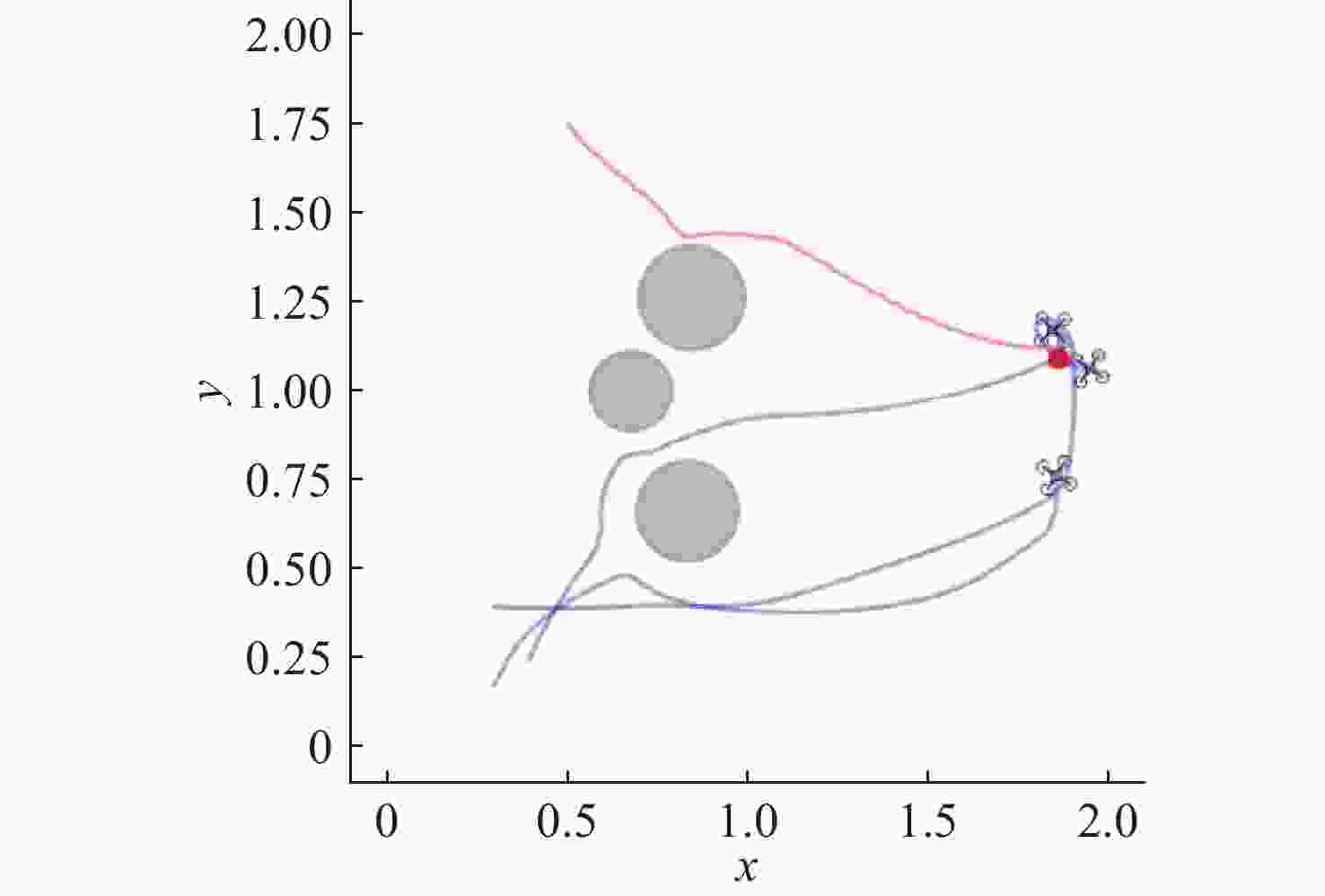
 下载:
下载:
